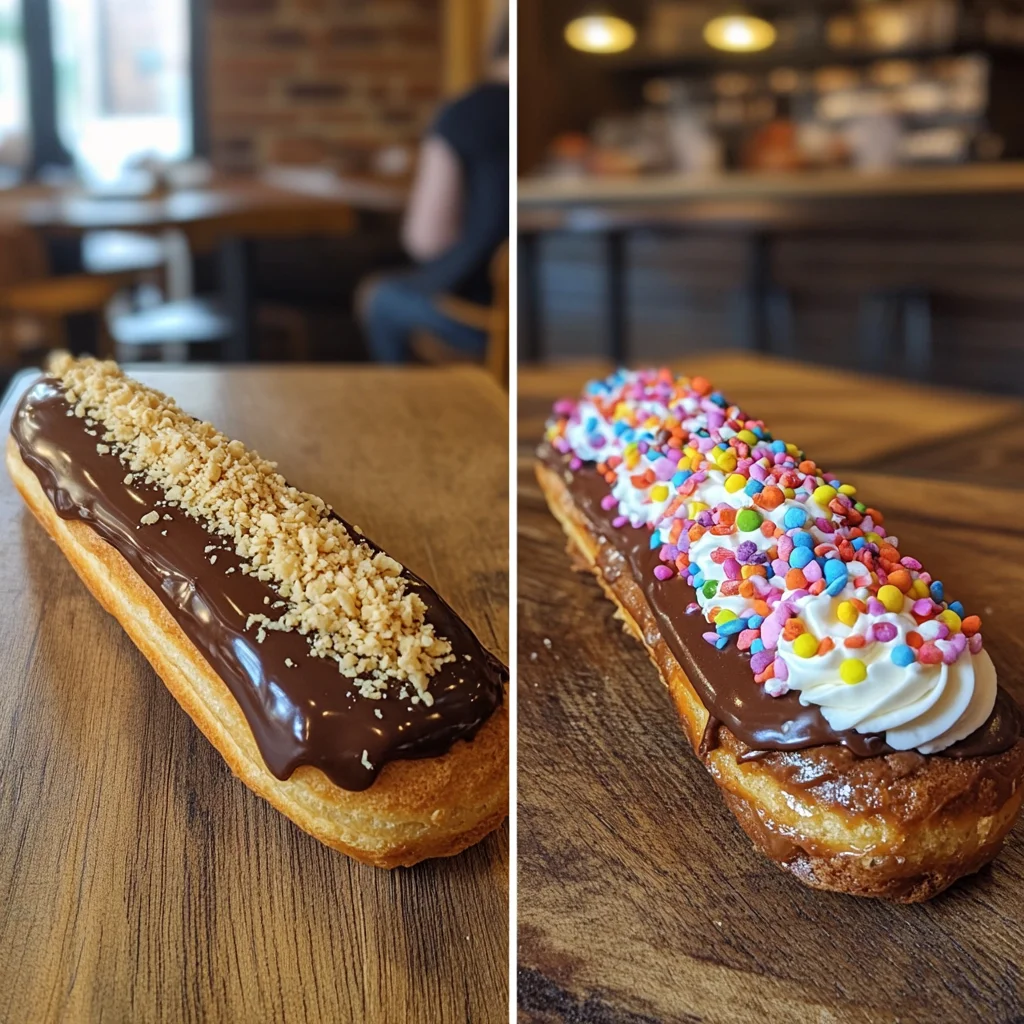The difference between an éclair and a French éclair may seem subtle at first glance, but these pastries hold a world of distinct features that separate them. An éclair, globally recognized as a choux pastry filled with cream and topped with glaze, has seen numerous adaptations outside France. On the other hand, the French éclair remains a symbol of culinary artistry, celebrated for its precision and rich heritage. Their unique characteristics have captured the hearts of pastry lovers worldwide.
While éclairs have gained popularity across various cultures, French éclairs are held in the highest regard for their refined textures, balanced flavors, and traditional methods. Understanding these nuances is essential for pastry enthusiasts who appreciate authenticity and craftsmanship.
The Basics of Éclairs
What is an Éclair?

An éclair is a classic pastry created using choux dough, a type of light and airy pastry dough. Shaped into an elongated form, éclairs are baked until crisp, then filled with creamy custard or pastry cream and finished with a sweet glaze. This dessert’s appeal lies in its combination of textures: a crisp shell, soft interior, and a smooth topping.
Although the difference between an éclair and a French éclair might not seem evident in its basic form, regional influences play a significant role in how this pastry is interpreted globally.
For a deeper dive into the signature components, see What is the Filling of an Éclair Called?.
Origins of the Éclair
The éclair’s roots trace back to 19th-century France, where chef Marie-Antoine Carême, often referred to as the “King of Chefs,” is credited with creating it. The term “éclair” translates to “flash of lightning” in French, possibly referring to how quickly one might devour this irresistible treat.
As the éclair spread across the world, it began to evolve, adapting to local tastes while retaining its foundational elements. This divergence is the basis for the difference between an éclair and a French éclair.
Common Ingredients Used in Éclairs
An éclair’s signature features stem from three essential components:
- Choux pastry: The light dough responsible for its crisp exterior.
- Pastry cream or custard: The rich, flavorful filling.
- Glaze: Often made of chocolate or fondant, lending a glossy finish.
What Makes a French Éclair?
Traditional French Éclairs vs. Modern Variations

The difference between an éclair and a French éclair begins with tradition. French éclairs adhere to strict pâtisserie standards, emphasizing quality and balance. The filling is usually a crème pâtissière, flavored with vanilla, coffee, or chocolate. In contrast, modern éclairs, particularly outside France, may feature whipped cream or inventive fillings like matcha or salted caramel.
French éclairs also emphasize refined aesthetics. The glaze is applied with precision, often with minimal decoration to highlight the pastry’s elegance.
Regional Preferences and Influences in France
In France, éclairs often reflect regional tastes. For example:
- Paris: Classic flavors like chocolate or coffee dominate.
- Provence: Lavender-infused éclairs occasionally appear.
- Alsace: Hazelnut or praline fillings are preferred.
These variations underline the regional pride that contributes to the difference between an éclair and a French éclair.
The Importance of French Pâtisserie Techniques
French éclairs are celebrated for their meticulous preparation. Every aspect, from the choux pastry’s piping to the glaze’s smooth finish, showcases expert craftsmanship. Techniques like double baking for a perfect crust exemplify the attention to detail in French pâtisserie.
Key Ingredients in a French Éclair
Choux Pastry
This dough is the cornerstone of the éclair. Its high moisture content creates steam during baking, resulting in a hollow yet sturdy structure.
Pastry Cream (Crème Pâtissière)
Crème pâtissière is a rich custard that serves as the filling for traditional French éclairs. Flavored with natural vanilla or coffee, it complements the pastry’s delicate texture.
Chocolate Glaze

The final touch is a glossy chocolate glaze, made using high-quality cocoa. It adds a bittersweet note, enhancing the pastry’s overall flavor.
Variations Around the World
American Éclairs

In the United States, éclairs are often larger and sweeter. Fillings like whipped cream or buttercream replace the traditional custard, contributing to a noticeable difference between an éclair and a French éclair.
European Adaptations
Across Europe, éclairs showcase diverse flavors:
- Italy: Espresso or ricotta-based fillings.
- Germany: Marzipan or nougat infusions.
Modern Twists in Global Bakeries
Global pastry chefs have reimagined éclairs with exotic ingredients such as matcha, passion fruit, or even savory fillings like cheese and herbs.
Differences in Taste and Texture
How Traditional French Éclairs Differ in Flavor
French éclairs prioritize subtlety and balance. The filling is never overly sweet, allowing the pastry’s delicate flavors to shine.
The Texture of Choux Pastry in French Éclairs
French éclairs feature a crisp, golden crust that contrasts beautifully with the creamy filling. This texture balance is a defining factor in the difference between an éclair and a French éclair.
Presentation Styles
French Éclairs as an Art Form
French éclairs represent an art form, blending culinary skill and visual appeal. Unlike their global counterparts, French éclairs are designed with precision, often featuring glossy glazes and delicate garnishes. The artistry lies in the balance of taste and aesthetics, where each component works in harmony to create a pastry that is as pleasing to the eyes as it is to the palate. This focus on detail underscores the difference between an éclair and a French éclair, as French versions prioritize minimalism and elegance.
Minimalist vs. Decorative Designs
French éclairs often lean toward minimalist designs, letting the quality of ingredients speak for itself. However, some pâtisseries take a more decorative approach, incorporating intricate patterns, edible gold leaf, or piped designs. While modern éclairs worldwide may prioritize flashy presentation, traditional French éclairs maintain a balance of beauty and simplicity that defines their timeless charm.
The Making of a French Éclair
Step-by-Step Traditional Process
Creating a French éclair involves a meticulous process. First, choux pastry is prepared by combining flour, butter, water, and eggs. The dough is then piped into elongated shapes and baked to perfection, forming a crisp shell. After cooling, the éclairs are filled with crème pâtissière, a rich custard that is a hallmark of French pâtisserie. Finally, a glossy glaze is applied to complete the dessert. This traditional method highlights the difference between an éclair and a French éclair, as authenticity relies on precise techniques.
Tips for Achieving Perfect Choux Pastry
The success of a French éclair depends heavily on the quality of the choux pastry. To achieve the perfect texture:
- Use precise measurements for all ingredients.
- Bake at a consistent temperature to ensure even puffing.
- Avoid opening the oven door during baking, as steam is crucial for the pastry to rise.
How Pastry Cream Defines the Experience
The filling of a French éclair, known as crème pâtissière, is essential to its flavor profile. Made with milk, sugar, egg yolks, and a touch of vanilla, this custard provides a creamy and smooth contrast to the crisp pastry shell. Its rich yet balanced taste sets French éclairs apart, emphasizing the difference between an éclair and a French éclair.
Comparing the Éclair and the French Éclair
Key Characteristics of a Classic Éclair
A classic éclair includes three essential components: choux pastry, cream filling, and glaze. However, classic éclairs often lack the refined textures and balanced flavors of their French counterparts. The global versions may include whipped cream or overly sweet toppings, deviating from the traditional French recipe.
Unique Traits of a French Éclair
The difference between an éclair and a French éclair lies in the attention to detail. French éclairs focus on quality ingredients and precise techniques. From the light and airy choux pastry to the silky custard filling, every element is carefully crafted. This dedication results in a pastry that is both luxurious and understated.
To ensure éclairs retain their ideal consistency, check out these tips on How to Keep Éclairs from Getting Soggy.
The Debate: Is There Really a Difference?
While some argue that all éclairs are fundamentally the same, connoisseurs insist that French éclairs are a class apart. Their emphasis on tradition, balanced sweetness, and artistry ensures that they remain a benchmark of excellence in pastry-making.
Common Misconceptions
Are All Éclairs French?
One common misconception is that all éclairs are inherently French. While the éclair originated in France, its global popularity has led to numerous variations. The difference between an éclair and a French éclair often lies in the execution, with non-French versions deviating from traditional techniques and ingredients.
Myths About French Éclairs
Many believe that French éclairs are overly complex or expensive to make, but this isn’t entirely true. While they require skill and high-quality ingredients, French éclairs can be made at home with patience and attention to detail. This dispels the myth that their charm is exclusive to professional pâtisseries.
Popular Fillings and Toppings
Classic Fillings Like Vanilla, Chocolate, and Coffee
Traditional French éclairs feature classic fillings such as vanilla, chocolate, or coffee crème pâtissière. These timeless flavors emphasize balance and quality, setting a standard for éclairs worldwide. The difference between an éclair and a French éclair often comes down to the authenticity of these classic fillings.
Creative Toppings in Modern Versions

Modern éclairs have embraced innovation, with toppings like salted caramel, matcha, and fruit compotes. While these creative variations are delightful, they often stray from the restrained elegance of French éclairs. French éclairs typically stick to simple glazes, ensuring the pastry’s core flavors shine.
How to Enjoy Éclairs the French Way
Pairing Éclairs with Beverages
To enjoy éclairs the French way, pair them with complementary beverages. Coffee, tea, or a glass of champagne are popular choices, as they enhance the pastry’s subtle sweetness. This pairing ritual further highlights the difference between an éclair and a French éclair, emphasizing an experience of indulgence and refinement.
The French Approach to Savoring Desserts
The French savor éclairs slowly, appreciating the interplay of textures and flavors. Unlike hurried consumption, the French approach involves mindful enjoyment, allowing the elegance of the pastry to be fully appreciated.
Where to Find Authentic French Éclairs
Famous Pâtisseries in France
For authentic French éclairs, visit renowned pâtisseries like Ladurée, Pierre Hermé, or Angelina in Paris. These establishments are celebrated for their dedication to tradition and innovation, offering éclairs that embody the difference between an éclair and a French éclair.
Top Locations Worldwide for Authentic Éclairs
Beyond France, several bakeries worldwide specialize in French éclairs. Look for bakeries that emphasize traditional techniques and high-quality ingredients. Cities like New York, Tokyo, and London have pâtisseries that bring French éclairs to international audiences.
Conclusion
Recap of the Key Differences
The difference between an éclair and a French éclair lies in the details. French éclairs excel in their balance of textures, refined flavors, and artistic presentation. While global adaptations offer creative twists, the authenticity of French éclairs remains unmatched.
Final Thoughts on the Charm of French Éclairs
French éclairs are more than just a dessert; they are a testament to the artistry of French pâtisserie. Whether enjoyed in a Parisian café or recreated at home, these pastries represent the elegance and dedication of culinary tradition.
FAQs
- What is the history of the éclair?
The éclair originated in 19th-century France, created by chef Marie-Antoine Carême. - Why are French éclairs considered superior?
French éclairs emphasize precision, tradition, and high-quality ingredients. - Can I make authentic French éclairs at home?
Yes, with the right recipe and attention to detail, you can recreate French éclairs in your kitchen. - What are the most popular flavors of French éclairs?
Classic flavors include vanilla, chocolate, coffee, and pistachio. - How are éclairs different from cream puffs?
Éclairs are elongated and filled with cream, while cream puffs are round and often topped with powdered sugar.

